As spring settles and the outdoors comes alive again, you might notice a steady rise in buzzing insects. For homeowners, this can be an unnerving experience. Due to the many different bee and stinging insect species that exist, it’s not a surprise that many people can’t tell the difference between them all. This is a concern for homeowners because not being able to distinguish what bee species they have around their home also means they cannot distinguish between which bees may be of concern and which are relatively harmless. In fact, this confusion is so common that we’ve come to expect the following question: “I have bees in my home, but I don’t know what kind they are… can you help?”
In an effort to help educate our customers and arm them with the knowledge to make the best pest control decisions for their families, this article will compare and contrast two common bee species: carpenter bees and bumblebees.
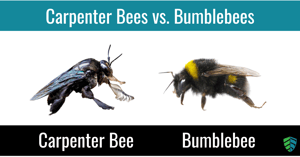
How many kinds of bees are there?
Bees play a crucial role in our ecosystem, serving as pollinators for many of the plants we rely on for food and other resources. While this article will primarily focus on just two different kinds, the fact is that there are thousands of different bee species a homeowner may encounter. According to the United States Geological Survey, there are over 20,000 known bee species throughout the world, with roughly 4,000 of those species being native to the United States. This results in millions of bee colonies spread throughout the States in any given year. And that’s just colonies alone - the number of individual bees is exponential!
How do carpenter bees and bumblebees differ in appearance?
When determining what kind of bee species you’ve encountered, one of the easier forms of identification is by observing the bee’s appearance. Luckily, carpenter bees and bumblebees have a few key differences in appearance that make them relatively easy to tell apart.
Carpenter bees are typically larger than bumblebees and have a shiny black or blue-black coloration. They are often mistaken for bumblebees because of their similar size and color, but carpenter bees have a smooth, hairless abdomen compared to bumblebees, which have a fuzzy or hairy abdomen. Carpenter bees also have wings that appear iridescent in sunlight, while bumblebee wings are more translucent.
Bumblebees are generally smaller than carpenter bees and have a fuzzy appearance with black and yellow stripes. Some species of bumblebees have additional markings or patterns on their bodies, such as red or white stripes. The fuzziness of bumblebees helps them collect and transport pollen, as the pollen sticks to their hair and is carried from flower to flower as they move around. This fuzziness is one of the key identifying factors in bumblebees.
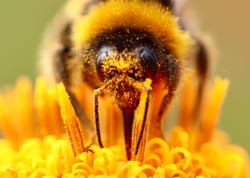 Bumblebee covered in yellow pollen
Bumblebee covered in yellow pollen
How do carpenter bees and bumblebees differ in behavior?
Another way to tell carpenter bees and bumblebees apart is by observing their behavior.
Carpenter bees are solitary insects, meaning they do not live in colonies or work together with other bees. They do not have a social structure like bumblebees or honeybees. Female carpenter bees are capable of stinging, but they’re generally not aggressive unless provoked. Carpenter bees are known for their habit of boring holes into wood to create nests, which can cause significant damage to wooden structures over time.
Conversely, bumblebees are social insects that live in colonies. They have a complex social structure that includes a queen, female workers, and male drones. Bumblebee colonies are usually much smaller than those of honeybees, with only a few hundred bees in the average colony. Bumblebees are also known for their ability to fly in colder temperatures, unlike most other bee species, making them important pollinators for early-blooming plants. However, bumblebees can be more aggressive than carpenter bees and are known to sting repeatedly if they feel threatened. Bumblebee workers and queens are the only members of the colony who will sting.
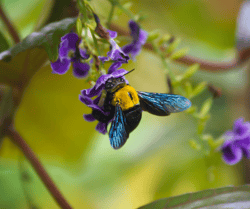 Carpenter bee on purple flower
Carpenter bee on purple flower
How do carpenter bees and bumblebees differ in nesting habits?
Carpenter bees and bumblebees can also be identified by their distinct nesting habits.
Carpenter bees create their nests by boring holes into wood, such as in wooden structures of your home or even dead trees. They prefer unpainted or weathered wood and they tend to choose wood that is soft or decayed. Once they have created their nest, the female carpenter bee will lay her eggs inside and the young bees will develop and emerge from the nest the following year. Carpenter bees are known to reuse their nests year after year. The tunnels they create over these years can cause serious structural damage to wooden structures.
In contrast, bumblebees nest in underground burrows, such as in abandoned rodent burrows, under stones or logs, or in thick grass. Bumblebees do not typically cause damage to structures like carpenter bees, but they can be a nuisance if their nests are disturbed. Because their nests are typically in or under the ground, they are often disturbed accidentally by unsuspecting homeowners. Bumblebee colonies are much smaller than those of honeybees, typically containing only a few hundred bees. The queen bumblebee will build a new nest each year, and the young bees will emerge in the spring to start the new colony.
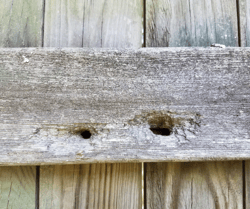 Carpenter bee nest entry holes
Carpenter bee nest entry holes
Are carpenter bees or bumblebees dangerous?
While neither species is considered aggressive by nature, both bees will protect their nests if they feel threatened.
Carpenter bees generally prefer to avoid people, and the males don’t even have a stinger. Female carpenter bees do have a stinger, but they rarely use it unless they feel threatened or provoked. While you typically don’t need to be concerned about a carpenter bee stinging you or your family, they can cause significant damage to your home through their wood-boring nesting habits. Returning carpenter bees can compound existing damage, eventually leading to potentially dangerous wooden structures with weakened structural integrity.
Bumblebees are also not naturally aggressive, but they can be more defensive than carpenter bees. If a bumblebee feels threatened, it may sting repeatedly, which can be painful and cause swelling or an allergic reaction in some people. However, like carpenter bees, bumblebees are important pollinators and play a vital role in maintaining healthy ecosystems.
While carpenter bees and bumblebees may be capable of causing harm, they are not typically dangerous. We encourage homeowners to respect and appreciate their important role in pollinating plants and maintaining healthy ecosystems.
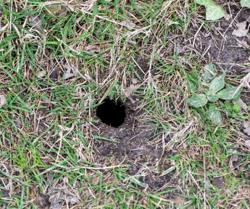 Homeowners are occasionally stung by bumblebees due to accidentally disturbing their nests, like the one pictured above.
Homeowners are occasionally stung by bumblebees due to accidentally disturbing their nests, like the one pictured above.
Can I prevent carpenter bees and bumblebees in or around my home?
Yes! At EcoShield, we believe prevention is always the best first line of defense against any pest, including carpenter bees and bumblebees.
Preventing carpenter bees can involve a few different strategies, including:
- Sealing off potential nesting sites: Carpenter bees are attracted to unpainted or weathered wood, so it's important to keep wooden surfaces on your property painted or sealed to make them less attractive to carpenter bees. Any potential nesting sites, such as cracks or holes in wood, should be filled in to prevent carpenter bees from accessing them.
- Installing physical barriers: You can also install physical barriers, such as screens or netting, over areas where carpenter bees may try to nest. This can prevent them from accessing these areas and help protect wooden structures on your property.
- Traps or “hotels”: Carpenter bee traps (sometimes referred to as carpenter bee hotels) can be an effective way to capture and remove carpenter bees from your property. These traps work by luring the bees inside and then trapping them in a container.
- Professional treatments: If carpenter bee infestations are persistent, it may be necessary to consult with a pest control professional like EcoShield.
Preventing bumblebees is generally not recommended as they play an incredibly important role in pollinating and maintaining healthy ecosystems. However, if you have concerns about bumblebees on your property, there are a few steps you can take to minimize their presence:
- Avoid attracting them: Bumblebees are attracted to flowers, so if you have a lot of flowering plants on your property, you may see more bumblebees. If you want to reduce the number of bumblebees around your home, you may want to consider planting fewer flowering plants or choosing varieties that are less attractive to bees.
- Keep your yard tidy: Bumblebees are attracted to overgrown areas and debris, so keeping your yard tidy and free of clutter can help minimize their presence.
- Block off potential nesting sites: Bumblebees typically nest in underground burrows, so if you have unused rodent burrows or other potential nesting sites on your property, you can block them off to discourage bumblebees from nesting there.
It's important to remember that bumblebees are beneficial insects and play an important role in pollinating plants. If you have concerns about bumblebees on your property, we encourage you to contact a local pest control professional like EcoShield for advice on how to manage the situation without harming these important pollinators.
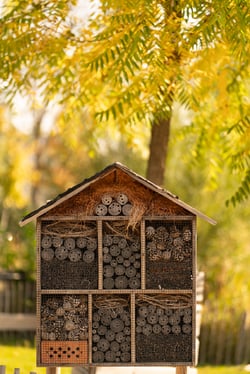 Example of a bee hotel
Example of a bee hotel
What should I do if I have a carpenter bee or bumblebee infestation?
If you’re experiencing an active carpenter bee or bumblebee infestation in or around your home, contact EcoShield today. Our knowledgeable pest technicians are standing by to provide you with customized pest treatment plans and expert guidance on how to navigate your specific pest infestation. With any stinging insect infestation, we highly recommend homeowners avoid DIY attempts at self-removal due to the inherent danger and risks involved. Instead, give EcoShield a call or fill out the form on this page today for a free no-obligation estimate!
EcoShield offers a one-time stinging insect removal service as well as routine pest prevention as part of our Home Shield Protection Plan. We also offer a highly specialized carpenter bee removal service to protect your home from costly carpenter bee damage and remediation. Ask about EcoShield’s stinging insect service options today!